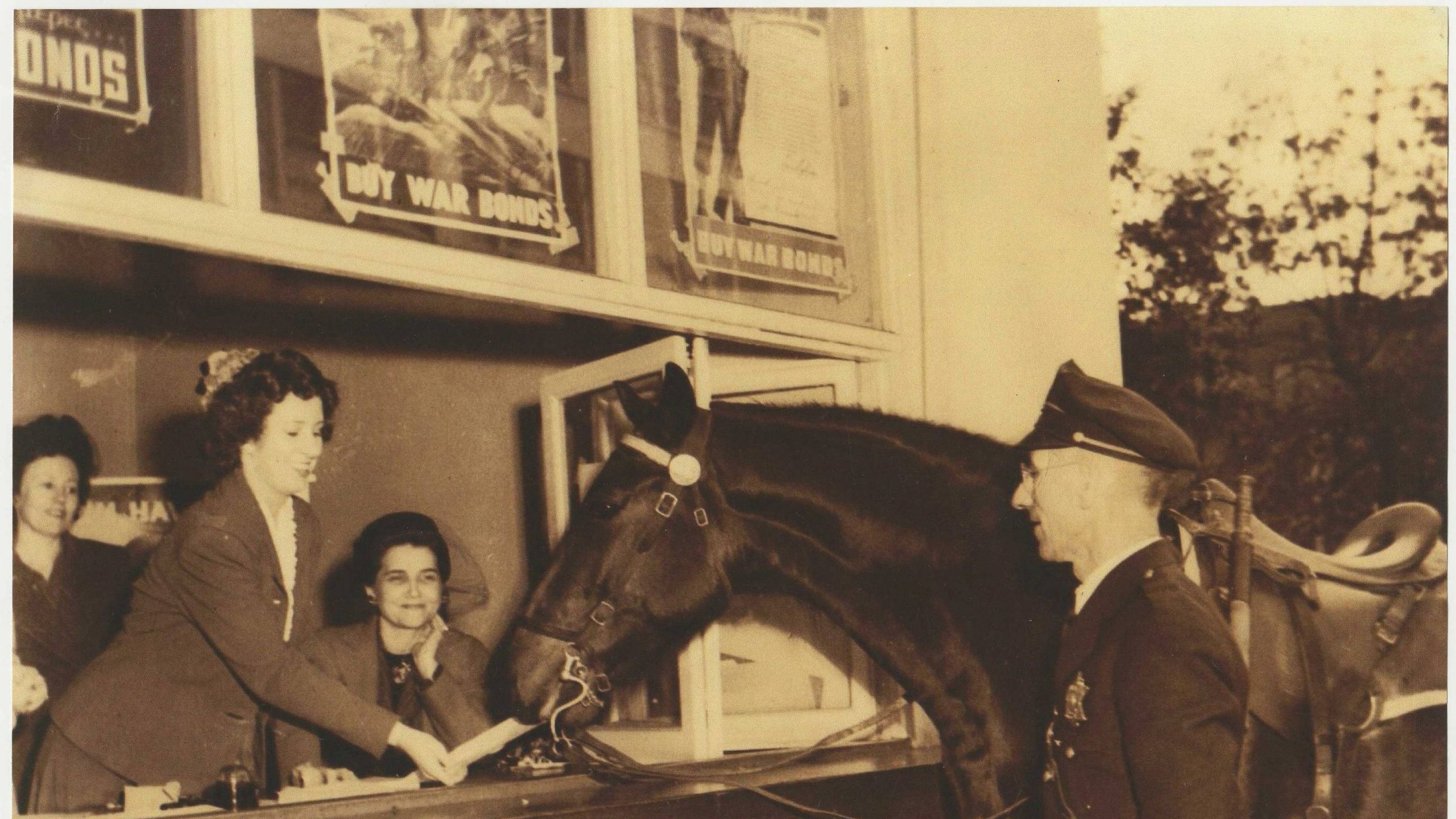On the evening of May 13, 1942, a bugler called Assembly in front of a small house in Downtown Memphis’s Court Square. The Bartlett High School band performed and presented the colors before Lucy Monroe, “The Star-Spangled Soprano” of radio fame, cut the ribbon to open the Victory House for business. For the next four years, Memphians bought millions of dollars of war bonds and stamps from volunteers staffing the booth as part of World War II’s homefront mobilization efforts.

War Bonds & Saving Stamps
World War II was an expensive war, and not only in terms of the number of lives lost and altered. According to the National WWII Museum, the United States spent an estimated $300 billion on the war effort (more than $4 trillion in 2022). The government needed additional sources of revenue to generate the funds, and the Treasury Department turned to American citizens for help.
The Treasury offered a series of war bonds for sale. Anyone could purchase a $25 bond for $18.75 (around $315 in 2022). Ten years from the date of purchase, they could redeem it for $25 (approximately $420 today).
President Franklin D. Roosevelt announced new Series E Bonds (also called Defense Savings Bonds) on April 30, 1941, and bought the first one himself. After Congress officially declared war following Japan’s attack on Pearl Harbor, the Treasury renamed the bonds War Bonds.
The Treasury also offered Defense Saving Stamps in small denominations – 10, 25, 50 cents; $1; and $5 – to encourage people, including children, to join the war effort. Individuals put their stamps in free albums. Once they filled in an album, it could be exchanged for a War Bond at a bank or Post Office.
Volunteer Effort
The Treasury relied heavily on volunteers to make the Savings Bond program work. Across the United States, individuals and communities rose to the challenge. Newspaper carriers sold stamps along their delivery routes, and movie theaters sold them at the box office. School children bought stamps at school. Advertising agencies voluntarily made posters, and newspapers, radio stations, and magazines supported ad campaigns. By 1944, the estimated value of time and space given for bond sales was over $250 million across the nation.
Unsurprisingly, given Memphis’s Jim Crow laws, war bond drives in Memphis were segregated along racial lines. In the white and Black communities, there were separate contests, committees, and activities. Over the course of the eight national War Loan Drives, Black and white Memphians collectively purchased over $300 million of bonds and stamps.

Four adults surround two children who are holding a $50 war bond. Courtesy of Memphis Public Libraries.

Victory House in Court Square
The Victory House built in Court Square, a public park set aside for white Memphians, was part of a national trend. Volunteers across the country created Victory Houses to promote war bond sales. Memphis Victory House became a locus of war bond sales and other patriotic gatherings from 1942-1945.

The city’s Building Trades Council erected the building, and the Women’s Group of the War Finance Committee ran it with a large number of female volunteers whose names were regularly printed in The Commercial Appeal. In September 1944, the chairperson estimated that over 2,000 women had volunteered their time at Victory House.
There were many PR stunts to encourage people to come to Court Square and buy bonds. On July 2, 1942, volunteers sold donated hams from the booth, with buyers getting war bonds and a ham for their purchase. On July 4, 1942, the Civil Air Patrol dropped 200,000 leaflets over homes and businesses, These flyers urged people to buy bonds at Victory House on the Fourth of July. Memphis’s Civil Air Patrol had two squadrons with 70 pilots and supporting ground crews and radio operators. Pilots paid for their own planes and fuel without government assistance. Later that month, Tarzan Jr. (actor Johnny Sheffield) made an appearance.



There were variety show entertainments, including Hal Burns and his singing dog. War bond purchases in exchange for Malco movie tickets and live radio quiz show tickets. Santa did photo ops, people made speeches, and actress Claire Trevor oversaw a rally that included the option for bond buyers to stamp their fingerprints on bombs. In June 1944, artist John Sabbatini drew crayon portraits on V-mail paper for anyone who bought a war bond during their lunch hour.


Volunteers staffed the Victory House most days, but they made special efforts during national loan drives. For the third load drive in 1943, bond buyers could add a soldier’s name to an honor scroll as a sponsor of a fleet of Memphis-built naval landing crafts. During the sixth drive in 1944, the Memphis Associated Retailers Bond Committee donated a thermometer to track progress towards Shelby County’s $30,191,000 goal.
Bond drives continued through 1945, even after the war officially ended. Advertising messages shifted from winning the war to bring the soldiers home. Victory House in Court Square continued to play a part in these efforts until workers dismantled it on January 12, 1946.
Caroline Mitchell Carrico is a native Memphian and, as a historian by training, she enjoys researching the city’s past and pulling it into the present. When she isn’t reading and writing, she can often be found cheering on her kids’ soccer teams.

